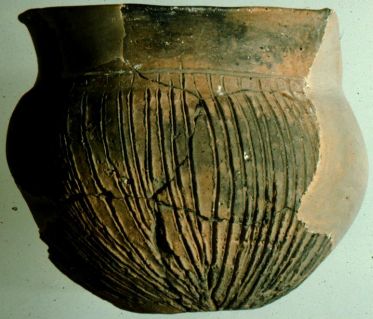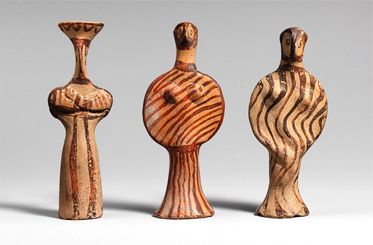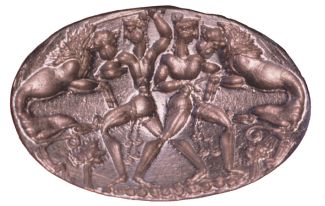Greece, Greek art during the Mycenean Period (1580-1120 B.C)
The civilization of the Myceneans was based on the mainland of Greece, roughly between Athens and Sparta. It ran from about 1580 to 1120 B.C. and was a time of affluence, judging from the profusion of gold, silver, and bronze jewelry and other objects
founds in Mycenean graves. Unlike the Minoans, whom they defeated, the Myceneans had strong fortresses. The twenty-foot thick walls were made from massive pieces of rock. In classical times, it was believed
that humans could not build such walls and that they were constructed by one-eyed giants called Cyclops. The Myceneans wrote and spoke a form of Indo-European, which scholars call Linear B.

Mycenean diadem[crown]; gold, found in burial site of a princess; ca. 1550 B.C.

Like their Minoan ancestor, Mycenaean potters decorated pottery mainly with plants or creatures. Sometimes, soldiers or hunters were depicted
in action on vases. Mycenaean pottery shows the beginnings of symmetry in structure and geometricizing forms of decoration-trademarks of what we identify as traditionally Greek in art.

Korakou, deep bowl, ca. 1200 B.C.; Dartmouth University Classics Department.
Sculpture from the Mycenaean period is divided into three types named for their resemblance to Greek letters: (a) Psi; (b) Tau, and (c) Phi. Below, the two on the right are phi statues; the one on the left
is Tau. They are thought to be goddesses, dressed in long, flowing robes. The eyes are important; they are made from individual slips of clay.

Terra-cotta sculpture, three goddesses, ca. 1400 to 1300 B.C. Heights: 10.8 cm.; 10.8 cm.; 10.5 cm.

Horned Warrior God, bronze, ca. 1200 B.C.; Cyprus, 35 cm., Enkomi, Cyprus, Nicosia, Cyprus Museum.

Gold roundels, from graves at Mycenae, ca. 1500 B.C., 6 cm in diameter; National Museum of Archaeology, Athens, Greece.

Ring, gold, bezel 33 x 22; inner diameter 18; ca. 1450 B.C.; heroes fighting lions, Beazely Archive, Peronne, Danicourt Museum.

Gold Drinking Cup (Kantharos); ca. 1550 B.C.; 21.24 cm. Metropolitan Museum of Art, New York.
|